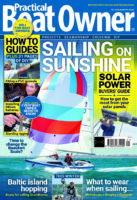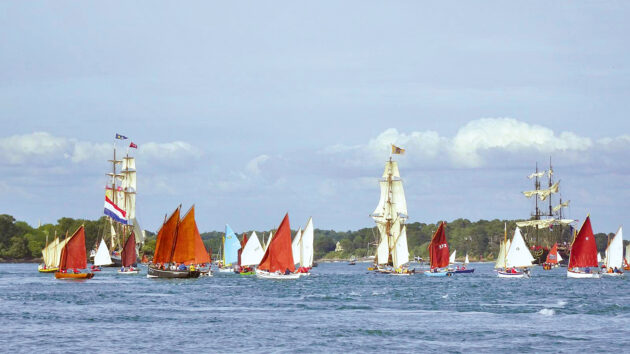The splendid La Semaine du Golfe de Morbihan brought Paul Hardy and over a thousand traditional sailing craft, including a fleet of nine Cape Cutter 19 trailer-sailers, to the Golfe de Morbihan. Expecting calm seas and beautiful islands, the fleet was surprised to encounter 8-knot tidal streams and treacherous whirlpools.
Your sailing education is not complete until you’ve sailed La Semaine, I’d been told by my sailing mentor. Calm seas, warm winds, beautiful islands and French cuisine. A regatta for sailing boats. What’s not to like?
No mention was made of the eight-knot currents in narrow channels, the risk of being swept out to sea, notorious navigational marks with spinning back-eddies, nor being run down by square riggers.
So, having received only half the story I signed up for this year’s event, held from 26 May to 1 June. So engaging was the proposition that eight other Cape Cutters decided to join me.
The splendid La Semaine de Golfe de Morbihan is a regatta held in the Golfe de Morbihan, southern Brittany, every two years. It promotes traditional sailing craft and the history of the seafarers and working boats from this region of France.
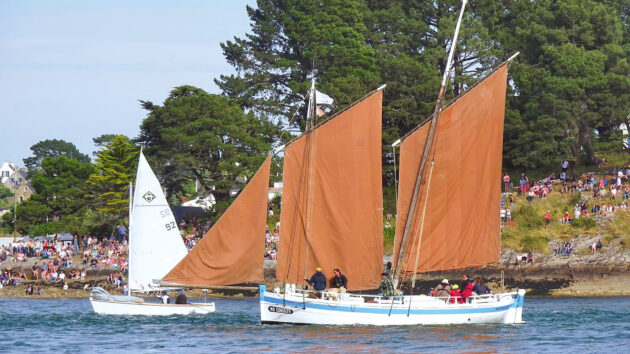
Traditional Brittany working boat. Photo: Paul Hardy.
The organisers have developed a polished, professionally-run programme that is a delight for all participants. Sign-up is easy and free; just email the organisers (contact@semainedugolfe.com). The La Semaine regatta attracts more than 1,000 craft from all over Europe, so it is best to get your name down early.
The organisers then allocate your boat to one of 11 flotillas. All the Cape Cutter 19s were placed in Flotilla I, ‘Petits Classiques habitables’ – for craft less than 8m with liveable cabins, which sort of describes our boats.
Trailer-sailer joys
With the organisers arranging a discount for the cross-Channel ferry, our trailer-sailers made speedy progress across La Manche to be greeted by the French customs who were keen to check our VAT paperwork. The first member of our group to cross the Channel and face immigration ended up on the ‘naughty step’ as the correct paperwork was not forthcoming.
Two hours later, his appropriate forms were raised. Our embarrassed skipper then hurriedly exchanged WhatsApp messages alerting the rest of us to what was required. For those still at home, the Royal Yachting Association website was scrutinised, forms printed, completed and in due course we were waved through by the customs officers. Simple!
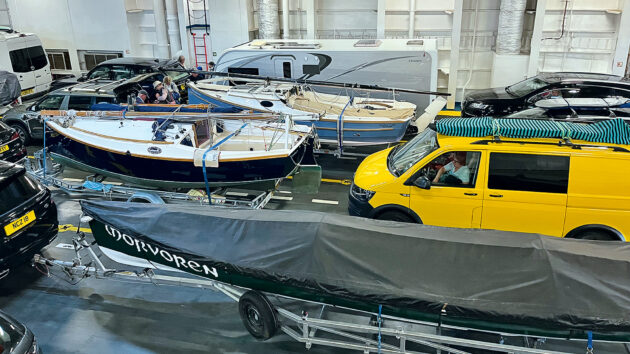
On the cross-Channel ferry – remember to keep self-inflating lifejackets ready for checks. Photo: Paul Hardy.
Interestingly, the ferry companies have some rather odd rules. Handheld flares and limited fuel can be taken on board for the crossing, but self-inflating lifejackets had to be scrutinised and shown to be securely stowed (in my car boot). There is a limit of six jackets per boat – fortunately, my crew and I only wore one each!
We arrived at Arradon, the slipway for Flotilla I , which could accommodate four boats launched side-by-side, had parking for cars and a field for trailers.
All sounds good until you realise 100 boats need space to rig, areas for turning and time to be launched and sailed away. While good humour was maintained, there was a certain amount of jostling for position.
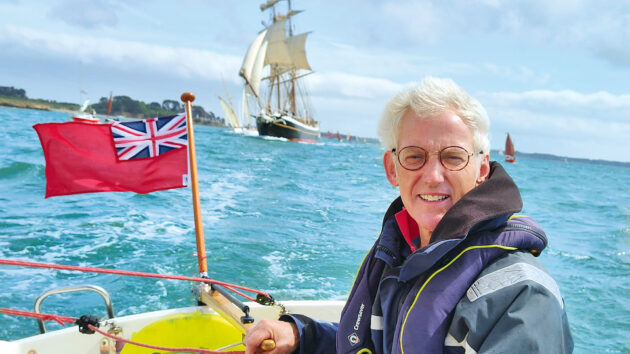
Paul inspired eight other Cape Cutter owners to take on the 2025 regatta. Photo: Paul Hardy.
First tests
Reversing car, boat and trailer down a busy slip with spectators giving marks for technical ability made for a daunting start. Launching complete, it was time to calm the nerves with a crêpe and a cold pint of the local cider.
Later that evening, as we sat at a waterside restaurant catching up with fellow Cape Cutter skippers, the setting sun sparkling on the calm water, boats rocking gently on the pontoon, enjoying our first taste of French cuisine, any anxieties over the journey so far evaporated in the warm evening air.
But the weather can change and day one of our ‘cruise’ started with two reefs and a challenging day’s sailing.
The ‘Golfe’ is well buoyed, and the channel fairly easy to find. In addition, with 100 boats in your flotilla it is almost a case of ‘follow my leader’.
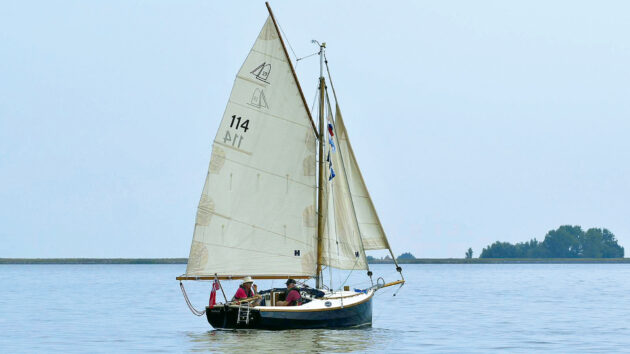
Paul has trailer-sailed Stardust to Scotland, and sailed from Largs to Oban, via the Crinan Canal. Photo: Paul Hardy.
What is not easy is tackling the tidal streams, which my mentor had skipped over in his introduction to La Semaine. At least, they are not easy until you get to know the best approach.
Normally, I’d give overfalls as wide a berth as possible – in my local port of Plymouth I would opt to wait for slack water at Devil’s Point as I enter the Hamoaze. Not so on these waters.
The Golfe de Morbihan has fast tidal races (during the week our Cape Cutters registered 10 knots speed over ground on their Sat Navs, even in light airs).
The best approach was: firstly, listen to the daily brief by your Flotilla Capitaine, who advises on navigational hazards and the time to depart the pontoon to ensure the tidal stream is in your favour and gives you the tidal window available for that day’s passage. (Each day’s direction of travel was with the tide in your favour.)
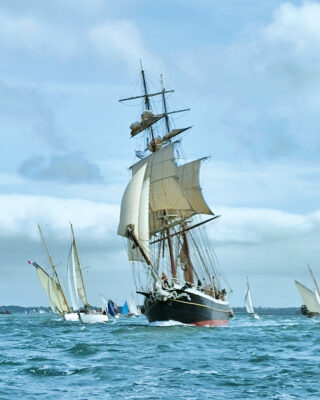
Traditional craft of all types at La Semaine du Golfe de Morbihan. Photo: Paul Hardy.
Secondly, steer into the turbulent water – this was where the strongest current ran to carry you to your destination. The turbulence could be narrow, so even if short tacking is required, tack, tack, and tack again.
Out of the tidal turbulence, the smooth water looks inviting but enter at your peril. The welling-up water carries large back eddies causing boats to go backwards or pirouetted as steerage is lost.
Navigational hazards at La Semaine
So two reefs and rough water sluicing between the rocks. What else did the Golfe have to offer navigators?
The answer is Le Grand Mouton and its chum Le Petit Mouton. The starboard hand mark of Le Grand Mouton shows its teeth four times daily as the tide rises and falls, with slack water seemingly non-existent.
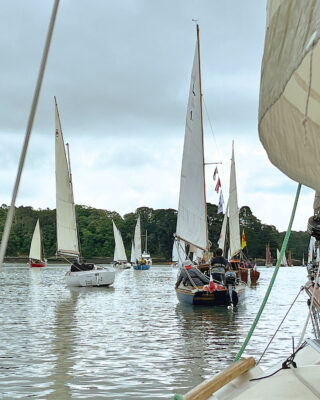
With a favourable tide and light airs the large 100-strong fleet drifts upriver to Auray. Photo: Paul Hardy.
Also, look out for the back eddy that waits to suck the unwary between Le Grand and Le Petit Mouton.
So, well reefed and briefed we sailed south through the well-marked channel, pushed along at a speed nearing 10 knots, mostly in control, at times less so.
The next issue was entry to Port Navalo for our lunch stop.
‘Keep to the right to avoid the Mouton marks and back-eddies’, advised our Flotilla Capitaine, ‘but don’t leave it too late to turn left to enter Port Navalo Harbour or you will be carried out to sea.’
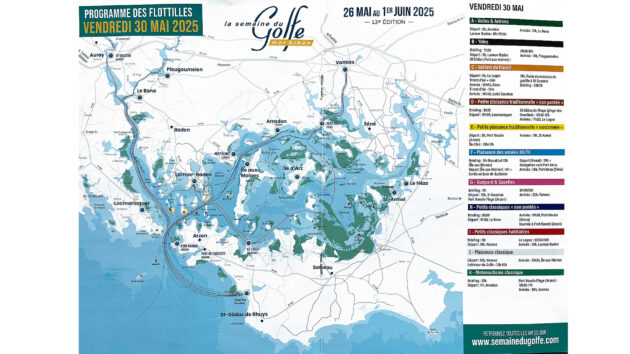
The programme chart. Photo: Paul Hardy.
Of our fleet of nine Cape Cutters, seven made a comfortable entry across the strong ebbing current to pick up a mooring buoy in the calm waters of Port Navolo, where a leisurely lunch was taken.
One bottled out and decided to go with the flow to anchor in a nearby bay and await the turning of the tide. The other bravely fought the ebbing tide and was rescued by a safety boat positioned by the organisers to cater for such an event.
Indeed, the rescue craft were kept busy as several skippers misjudged their vectors, underestimating the current strength to end up out at sea. Invariably, the event organisers had craft at key points to direct skippers to a safe passage – or to pass a tow line.
French hospitality
Running alongside the traditional rigged boat sailing, La Semaine offers a host of social events.
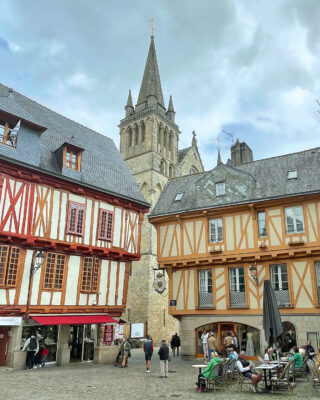
Old town, Vannes – a beautiful medieval city but entry is limited by a tidal gate. Photo: Paul Hardy.
In many ports, the local teams would provide baguettes and jam plus coffee for free while we awaited the Flotilla Capitaine’s daily briefing. Many of us also took the opportunity to dash to the boulangerie for fresh bread or croissants.
We visited Port Navalo on several occasions. Here, like many of the ports we visited, there were free water taxis to get us ashore where we were greeted by a festival atmosphere.
Marquees were rigged to supply a variety of French food including galette and crêpes, and local cider to sample. Market stalls offered La Semaine merchandise or local craft. Plus a variety of entertainment on stage.
As many of the sea-shanties had familiar tunes we participated in our own way, the cider only helping our pronunciation of our schoolboy French. Oh, how I wished I’d listened more carefully in class!
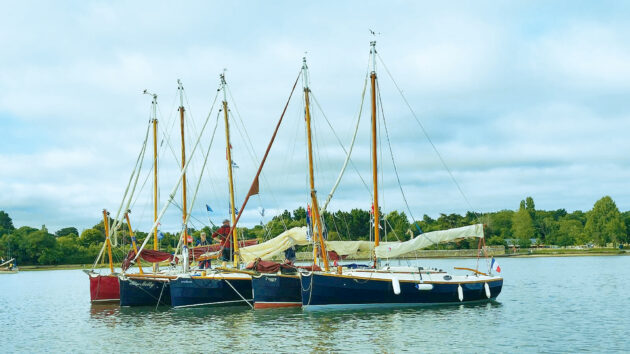
Centre plate down, gin pennant up; rafted, the Cape Cutters wait for the tide to enter Vannes. Photo: Paul Hardy.
In the evenings more food and entertainment were provided. There were opportunities to sit and talk through the day’s events in a marquee provided by the organising committee or to walk into town to check out the local restaurants.
In the centre of the Golfe de Morbihan are two large islands. One is Ile aux Moines (Island of the Monks) which I visited after the regatta by foot when my wife came out to join me. This beautiful, peaceful place is worth a day’s exploring. A stopover to the Ile d’Arz formed a part of our flotilla’s itinerary during the week.
Several other flotillas visited the island on the same day. With more than 200 boats, the mooring buoys were soon filled up so plan B was to run the boats onto the beach.
The wise organisers had timed our arrival on the falling tide, to give us a four-hour window to lunch and relax before the rising tide sent us on our way.
Cape Cutters can happily take the ground; safely on the soft, sandy beach, it was just a short walk to the entertainment.
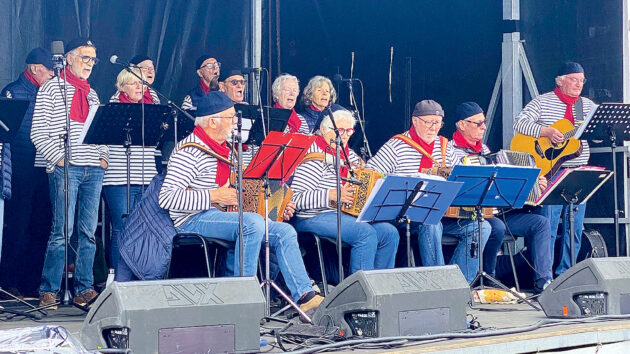
The regatta has apacked programme ashore including traditional folk music and entertainment. Photo: Paul Hardy.
Grabbing a bite from the marquees before settling down on the grass in the shade of pine trees, we were treated to traditional folk dancing, music, and more. There was also time to walk into town.
While some of the sailing is fast paced, much of the shore time is spent at relaxed tempo.
Congestion challenge
The city of Vannes deserves a special mention. Firstly, the entry. With the tide gently nudging us along and the wind dropping, we approached Vannes; here, there is a tidal gate to get into the port.
Unfortunately, we all arrived a little early, which meant some 100 boats in confined waters and a pushing tide.
But, no problem, we all had motors and could jockey around to keep station. Well, until the ferry arrives – and the ‘traditional’ Viking Long Boat, with tricky steerage and bearing metal shields for fenders puts in an appearance – time for plan B.
Drawing just 0.5m and aware the shallow water has a muddy bottom and the tide is rising, the Cape Cutters left the by now chaotic narrow channel and ‘moored’ by dropping their centre plates to sit it out.
We ended up with a five-boat raft, and when one skipper raised the gin pennant, a sociable hour whizzed past (although I did put an anchor out as the tide lifted our plates out of the mud).
As the congestion eased, I started to move into the channel, only to be beckoned by a French skipper tied up alongside the quay, who said: ’The entry canal is still too busy and narrow, you’d be better sharing a glass of wine with me until it is quieter’. How sensible, how kind.
Secondly, the port is beautiful. The medieval town is a chaotic conglomeration of overhanging oak-beamed buildings, cobbled streets, manicured gardens and ancient battlements, embedded with high-quality shops and restaurants.
Again savouring a meal taken under the stars, impressed by the town’s flood-lighting of the boats on their pontoons, there was no need to ask if we were having a great time.
Navigation notes from La Semaine
The Golfe de Morbihan is relatively easy to sail, provided basic navigational practice is followed.
The organisers will send out a tide table. Check this out as all sailing is tide dependent, especially so in the Golfe.
The navigational marks set out the basics, but be careful in the eastern part of the Golfe as there is much shallow water.
The organisers provide a booklet providing mini-charts of harbours which are easy to use and informative.
I ordered an Imray paper chart on the internet for the Golfe, just in case, but never used it. I downloaded the Garmin Boating App on my phone which was really useful, and my crew downloaded a similar programme.
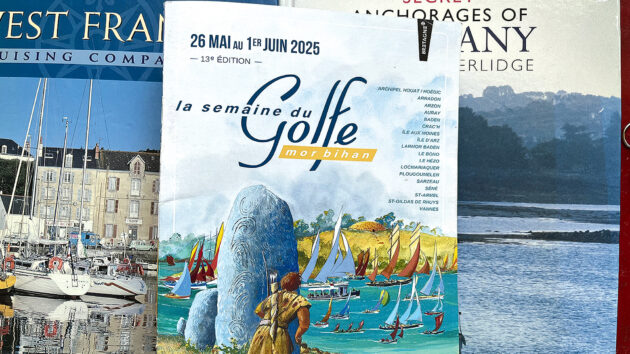
Useful reading: Yachting Monthly’s Cruising West France, the event programme and Secret Anchorages of Brittany. Photo: Paul Hardy.
To update my Garmin/Navionics chartplotter on my boat was just too much money to download the whole of West Europe for one week’s use.
However, most local chandlers sell a laminated chart of the Golfe and I would suggest that if you want a hard copy chart, you buy this on arrival. My mentor said he navigated from a table place mat (also readily available by local purchase), but who knows?
The organisers will also send out navigational notes prior to the event and a booklet to collect at registration. These are more than comprehensive but are written in French. My crew managed to download an English translation which offered valuable information (especially regarding Le Grand Mouton).
I purchased pre-loved books: West Coast Cruising Companion – Featherstone, Atlantic France- Parkinson and Secret Anchorages of Brittany –Peter Cumberlidge. However I found that the booklet the organisers offered had all the information that was required for the Golfe.
Learning points from La Semaine Regatta
- Check-out boat import to EU documents. At least one of our Cape Cutter skippers was held up by failing to present the correct documentation. The RYA has helpful guidance.
- Have your self-inflating lifejackets readily available (and safely stowed) – they may be scrutinised.
- Arrive early (and leave late) to avoid slipway congestion. One of our Cape Cutters opted to be craned in to avoid the slipway logjam and arrived calm and collected.
- Learn to love the turbulent water, this is where the favourable current is best.
- The French organisers do an amazing job of co-ordinating the event and entry is free. Apply early and check you’ve been allocated to an appropriate flotilla.
- Add this event to your bucket list of sailing destinations now!
Paul Hardy, a retired general practitioner (GP), learnt to sail dinghies when stationed in Singapore with the RAF. An RYA Senior Dinghy Instructor and Yachtmaster Alan and his partner, Rosemary, live aboard the Moody 376 Linga Linga which is now permanently berthed in Malta.
Want to read more articles about races like La Semaine?
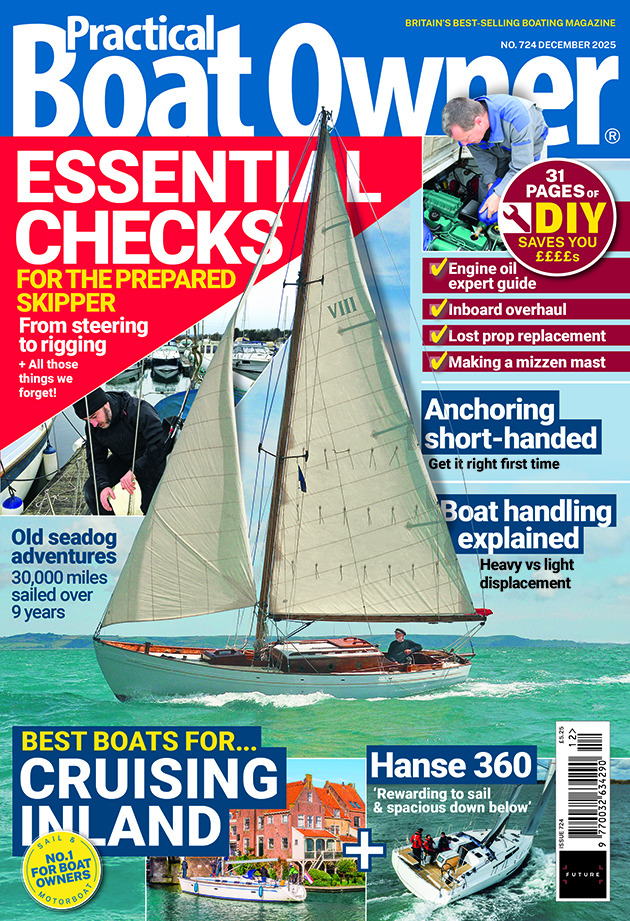
A subscription to Practical Boat Owner magazine costs around 40% less than the cover price.
Print and digital editions are available through Magazines Direct – where you can also find the latest deals.
PBO is packed with information to help you get the most from boat ownership – whether sail or power.
-
-
-
- Take your DIY skills to the next level with trusted advice on boat maintenance and repairs
- Impartial, in-depth gear reviews
- Practical cruising tips for making the most of your time afloat
-
-
Follow us on Facebook, Instagram, TikTok and Twitter

